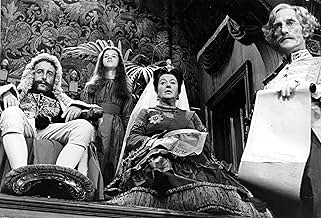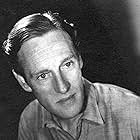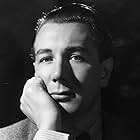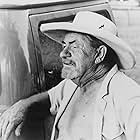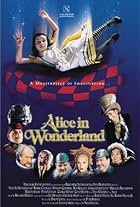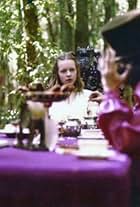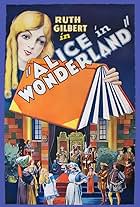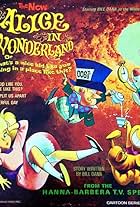A girl named Alice falls down a rabbit-hole and wanders into the strange Wonderland.A girl named Alice falls down a rabbit-hole and wanders into the strange Wonderland.A girl named Alice falls down a rabbit-hole and wanders into the strange Wonderland.
Jo Maxwell Muller
- Alice's Sister
- (as Jo Maxwell-Muller)
Michael Redgrave
- Caterpillar
- (as Sir Michael Redgrave)
Anthony Trent
- Fish Footman
- (as Tony Trent)
- …
Wilfrid Lawson
- Dormouse
- (as Wilfred Lawson)
- Director
- Writers
- All cast & crew
- Production, box office & more at IMDbPro
Storyline
Did you know
- TriviaWriter, Producer, and Director Jonathan Miller explained that the reason that none of the actors or actresses (even those playing non-human characters) wore costumes aside from Victorian period dress, was that he thought it was ridiculous to get big name stars to play parts (as he did in this movie and MGM had done in Alice in Wonderland (1933)) and then cover them up in big costume animal heads so they were unrecognizable.
- GoofsIn the scenes with the Mock Turtle, his legs are crossed in all the long shots, but in close-up shots, his legs are in a completely different position; without there being enough time to have changed them from one shot and another.
- Crazy creditsThe "cast in order of appearance" is slightly incorrect. The cast lists the Mock Turtle (Sir John Gielgud), the Gryphon (Malcolm Muggeridge) and the Executioner (David Battley) in that order. In fact the Executioner appears first in the scenes with the King and Queen of Hearts, and then the Gryphon appears in order to take Alice to the Mock Turtle, who appears last.
- ConnectionsFeatured in The Worlds of Fantasy: The Child Within (2008)
Featured review
Beautifully filmed in a satiny black & white reminiscent of old photographs, this 1966 BBC adaptation of "Alice's Adventures in Wonderland" may displease purists for its less than conventional, as well as decidedly minimalist, approach. It's not a traditional rendering of Lewis Carroll, and doesn't pretend to be; there are no phantasmagoric sets or actors encased in over-sized costumes or big musical numbers or fancy photographic effects. The Alice of this production is a taciturn, stony-faced girl who is neither frightened nor fascinated by her experiences in Wonderland, which is mostly made up of the interiors and exteriors of old English mansions and houses. But in its unorthodox way, it brings Carroll's text to life in a way I don't recall experiencing in other adaptations of the Alice books.
It's apparent that in creating this alternative Alice, producer-director Jonathan Miller expects you to be already familiar with its source; he's evidently assuming you will recognize what he's chosen to leave in as well as leave out, as well as his re-imagined settings. Only a few of the actors are made to look anything like the characters in the Tenniel drawings, such as Leo McKern as the Duchess or Peter Cook as the Mad Hatter; you're basically on your own when it comes to spotting the White Rabbit or Caterpillar or Frog Footman, all of whom are dressed "normally" in period costumes. (Presenting the Carrollian characters as real people isn't a new idea; I recall a TV adaptation of Alice starring Kate Burton in which Humpty Dumpty was portrayed by an elderly man in a rocking chair.)
By tossing out entire scenes, characters and exchanges that were in the book, Miller gives us a sparer, edgier retelling of the Wonderland story, but doesn't stray too far from the original. Why such a sullen, passive Alice? My guess is, this is supposed to be an Alice who fully realizes that she's in a dream and treats her surroundings accordingly.
And so this Alice (played by a charming Anne-Marie Mallik) sits looking bored and disinterested during the Mad Tea Party. Other productions customarily play this scene with all kinds of manic energy, but in this film, the tea party is deliberately drawn out with long, open rhythms reminiscent of an Antonioni or Resnais film. (Alice's Adventures in Marienbad, anyone?) And seemingly for the first time, while I was listening to the Mad Hatter, the March Hare and the Dormouse prattle away, their nonsense started to make wonderful sense. It's easy enough for an actor to recite lines like, "What day of the month is it?," but here, the performers sound like they really mean what they say (and say what they mean).
That same emphasis on dialogue is apparent in the beach scene with the Mock Turtle, played by Sir John Gielgud, and the Gryphon, played by Malcolm Muggeridge. The Mock Turtle's words never sounded so delightful to me before, and thank goodness Gielgud didn't have to deliver them through some huge Mock Turtle mask. This scene also provides one of the movie's most striking images, of the Mock Turtle, the Gryphon and Alice walking barefoot along the shore, with Gielgud softly singing the "Lobster Quadrille" a cappella.
For those seeking a more conventional book-to-film translation of "Alice," I would suggest the 1972 British movie musical starring Fiona Fullerton, complete with elaborate sets and costumes and velvety color photography and songs. Although it was slammed by the relatively few reviewers who saw it, I thought it nicely conveyed a dreamlike quality of its own, especially in its transitions - I found it much more enjoyable than the 1933 Paramount movie or the 1951 Disney animated feature.
But if you think you've had your fill of Alice movies and TV shows, then I urge you to try this one - I think it makes Lewis Carroll sound fresh all over again. (There's very interesting musical accompaniment by Ravi Shankar.) And for a wonderfully acted movie about the real- life Alice Liddell Hargreaves and Lewis Carroll, I urge you to see "Dreamchild" - but that's another review.
It's apparent that in creating this alternative Alice, producer-director Jonathan Miller expects you to be already familiar with its source; he's evidently assuming you will recognize what he's chosen to leave in as well as leave out, as well as his re-imagined settings. Only a few of the actors are made to look anything like the characters in the Tenniel drawings, such as Leo McKern as the Duchess or Peter Cook as the Mad Hatter; you're basically on your own when it comes to spotting the White Rabbit or Caterpillar or Frog Footman, all of whom are dressed "normally" in period costumes. (Presenting the Carrollian characters as real people isn't a new idea; I recall a TV adaptation of Alice starring Kate Burton in which Humpty Dumpty was portrayed by an elderly man in a rocking chair.)
By tossing out entire scenes, characters and exchanges that were in the book, Miller gives us a sparer, edgier retelling of the Wonderland story, but doesn't stray too far from the original. Why such a sullen, passive Alice? My guess is, this is supposed to be an Alice who fully realizes that she's in a dream and treats her surroundings accordingly.
And so this Alice (played by a charming Anne-Marie Mallik) sits looking bored and disinterested during the Mad Tea Party. Other productions customarily play this scene with all kinds of manic energy, but in this film, the tea party is deliberately drawn out with long, open rhythms reminiscent of an Antonioni or Resnais film. (Alice's Adventures in Marienbad, anyone?) And seemingly for the first time, while I was listening to the Mad Hatter, the March Hare and the Dormouse prattle away, their nonsense started to make wonderful sense. It's easy enough for an actor to recite lines like, "What day of the month is it?," but here, the performers sound like they really mean what they say (and say what they mean).
That same emphasis on dialogue is apparent in the beach scene with the Mock Turtle, played by Sir John Gielgud, and the Gryphon, played by Malcolm Muggeridge. The Mock Turtle's words never sounded so delightful to me before, and thank goodness Gielgud didn't have to deliver them through some huge Mock Turtle mask. This scene also provides one of the movie's most striking images, of the Mock Turtle, the Gryphon and Alice walking barefoot along the shore, with Gielgud softly singing the "Lobster Quadrille" a cappella.
For those seeking a more conventional book-to-film translation of "Alice," I would suggest the 1972 British movie musical starring Fiona Fullerton, complete with elaborate sets and costumes and velvety color photography and songs. Although it was slammed by the relatively few reviewers who saw it, I thought it nicely conveyed a dreamlike quality of its own, especially in its transitions - I found it much more enjoyable than the 1933 Paramount movie or the 1951 Disney animated feature.
But if you think you've had your fill of Alice movies and TV shows, then I urge you to try this one - I think it makes Lewis Carroll sound fresh all over again. (There's very interesting musical accompaniment by Ravi Shankar.) And for a wonderfully acted movie about the real- life Alice Liddell Hargreaves and Lewis Carroll, I urge you to see "Dreamchild" - but that's another review.
Details
- Release date
- Country of origin
- Official site
- Language
- Also known as
- Alice Harikalar Diyarında
- Filming locations
- Production company
- See more company credits at IMDbPro
- Runtime1 hour 12 minutes
- Color
- Sound mix
- Aspect ratio
- 1.33 : 1
Contribute to this page
Suggest an edit or add missing content







